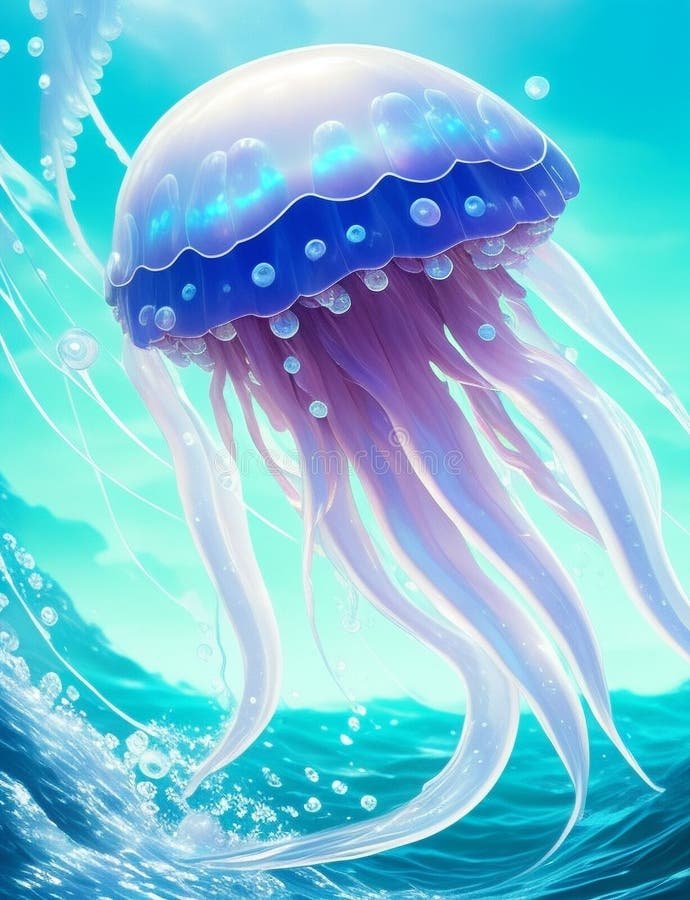
Jellyfish are among the oldest living creatures on Earth, dating back over 500 million years. They don’t have a traditional nervous system or brain, which might make you think they’re at a disadvantage. But here’s the thing: their unique body structure and biology allow them to thrive in various ocean environments. They navigate using a blend of instinct, environmental cues, and even chemical signals. So, let’s dive into the amazing world of jellyfish, exploring how they navigate the deep sea and communicate with each other.
The Anatomy of a Jellyfish
To understand how jellyfish navigate and communicate, it’s essential to first look at their anatomy. Jellyfish are primarily made up of a gelatinous substance called mesoglea, which gives them their umbrella-like shape. This structure is crucial not only for their unique appearance but also for their movement.
Their bodies consist of two main layers: the outer layer called the epidermis and the inner layer called the gastrodermis. Between these layers is the mesoglea, which is mostly water. This watery composition helps them stay buoyant in the ocean.
Jellyfish also have specialized cells called cnidocytes, which contain stinging structures called nematocysts. These cells help jellyfish capture prey and defend against predators. When we think about navigation, these stinging cells are part of what makes jellyfish successful hunters. They can move quickly when threatened or when they want to catch food, relying on their body’s rhythm to propel them through the water.
Movement and Navigation
You might be wondering how jellyfish get around without a central nervous system. Rather than swimming in a straight line like fish, jellyfish use a unique method of movement. They contract and relax their bell-shaped body, pushing water behind them. This simple yet effective pulsing motion allows them to glide through the ocean.
Here’s where it gets interesting: they don’t just move randomly. Instead, jellyfish are great at using ocean currents to their advantage. They can drift along with the tide, conserving energy and going where the water takes them. Imagine riding a wave at the beach; sometimes, you just let it carry you to shore.
They also possess specialized sensors called statocysts that help them with orientation. These tiny organs allow jellyfish to detect gravity and maintain their balance in the water, ensuring they don’t drift too deep or float too high. This sensory input is vital for them to find food and avoid dangers in their environment.
Communication Through Chemical Signals
Communication for jellyfish isn’t like how we think about it. Without a complex brain or vocal cords, they rely heavily on chemical signals. These signals are released into the water and can be detected by other jellyfish.
When a jellyfish releases certain chemicals, it can send messages about food sources or establish territory. For example, if one jellyfish finds prey, it might release specific chemicals that alert nearby jellyfish to the food’s presence. It’s like throwing out a breadcrumb trail for others to follow.
This type of chemical communication is called chemoreception. It allows jellyfish to sense their surroundings, making it crucial for their survival. If you think about it, it’s a bit like using smell to find a restaurant—it guides you toward a meal!
Light and Bioluminescence in Jellyfish
Another fascinating aspect of jellyfish communication involves light, particularly bioluminescence. Some jellyfish have the ability to produce light using a chemical reaction within their bodies. This light can serve various purposes.
For one, jellyfish use bioluminescence as a defense mechanism. When threatened, they can emit a glow that attracts predators, allowing them to escape while the predator is distracted. It’s a clever way to turn the tables!
Additionally, bioluminescence can play a role in communication among jellyfish. When they light up, it can signal to others nearby, perhaps helping them coordinate their movements or warn them of danger.
Imagine being able to send a flashing light message in the dark ocean—it’s a beautiful language of light that is both mesmerizing and functional.
The Role of Environmental Cues
Aside from their physical abilities and chemical signals, jellyfish also rely heavily on environmental cues for navigation. They can sense changes in water temperature, salinity, and even light intensity. These cues help them determine their surroundings and find food sources.
For instance, when jellyfish are in warmer waters, they often bloom in large numbers. This change in temperature can trigger their movement patterns, leading them to areas rich in prey. Think of it as following the scent of your favorite food; the smell draws you in that direction.
Moreover, jellyfish can respond to the position of the sun. By sensing light, they can adjust their depth in the water column, ensuring they remain in optimal conditions for hunting and safety. It’s a fantastic example of how they adapt to their environment.
When we take a closer look, it’s clear that jellyfish are more than just beautiful creatures drifting through the ocean. Their ability to navigate and communicate in a world without a brain or traditional senses is nothing short of remarkable. From their rhythmic movements to their chemical signals and even bioluminescent displays, jellyfish have honed their skills over millions of years.
These adaptations are essential for survival in the vast ocean, showcasing the elegance of nature. So, the next time you see a jellyfish floating gracefully in the water, remember the intricate ways it navigates and communicates. They truly are the marvels of the sea!

